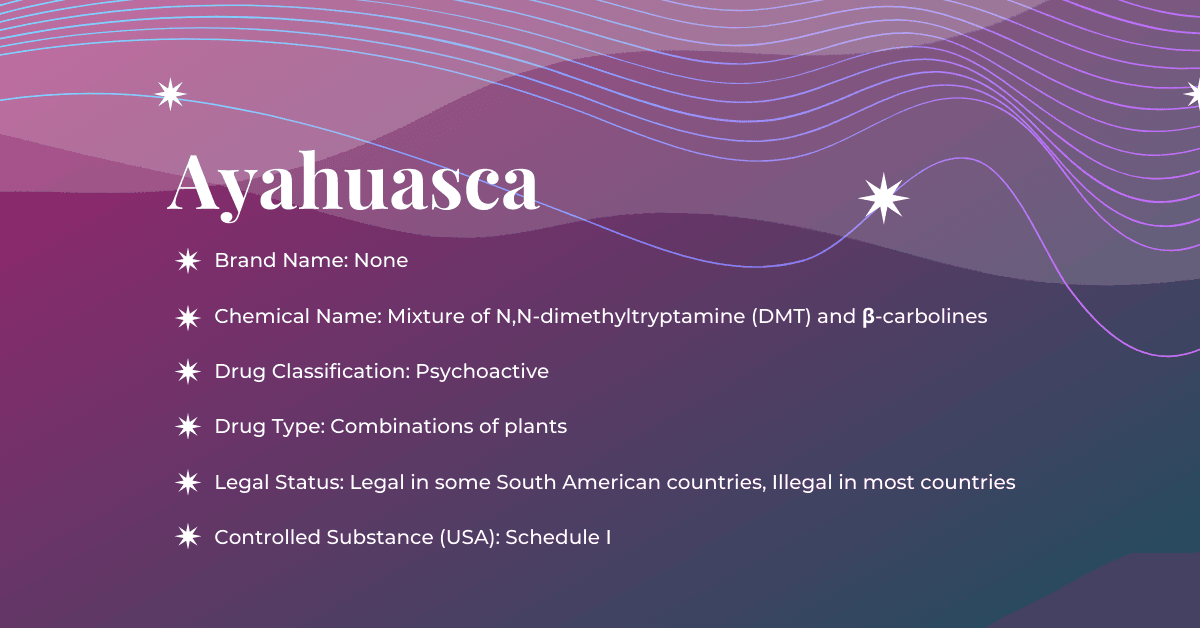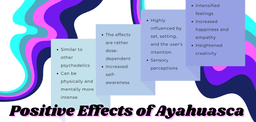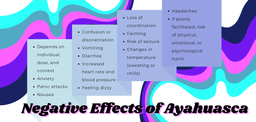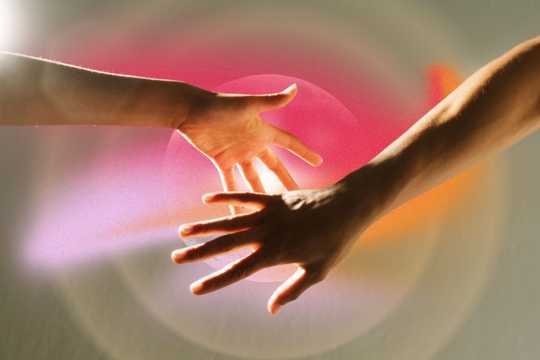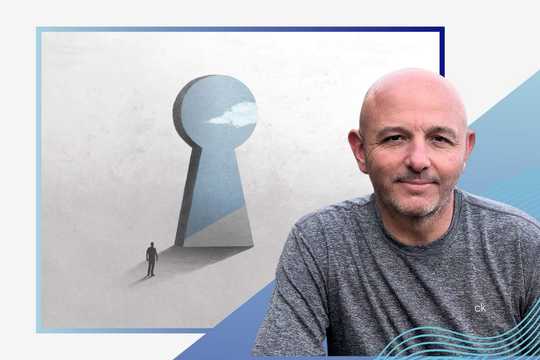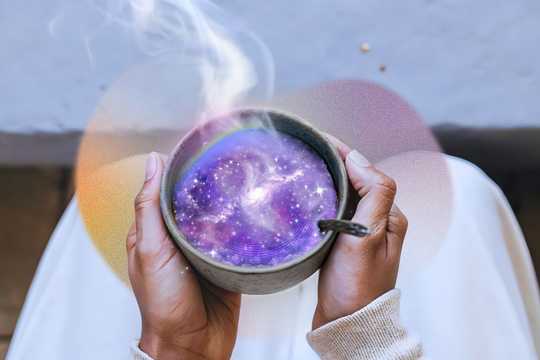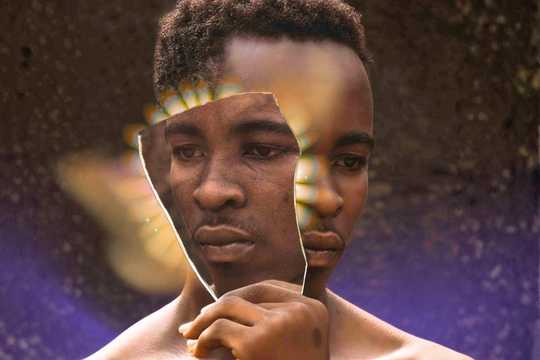Here’s our ayahuasca substance guide covering the historical and cultural context, ceremonial use, how it works in the brain, its effects, and potential health benefits.
Drug Class
Ayahuasca (pronounced ah-yuh-wah-skuh) is a mixture of plants with psychoactive properties traditionally used in spiritual and medicinal practices by Indigenous cultures of the Amazon basin. It contains N,N-dimethyltryptamine (DMT), a naturally occurring psychedelic tryptamine classified as a classical psychedelic substance, and β-carbolines (e.g., harmine, tetrahydroharmine, and harmaline), which act to inhibit monoamine oxidase enzymes in the gut and allow DMT to reach the brain. Ayahuasca is known as a plant medicine and entheogenic compound.
What is Ayahuasca?
Ayahuasca is a mixture of two or more plants commonly prepared from the Banisteriopsis caapi vine and the Psychotria viridis shrub. The latter is rich in DMT, and the vine contains monoamine oxidase inhibitors (MAOIs). The combination allows DMT to become orally active and produce its characteristic effects, often used in rituals for healing, self-discovery, and spiritual connection. People commonly refer to the plant mixture as “ayahuasca,” and the prepared drink is a “tea” or “brew.” In the Quechua language of the Indigenous people of South America, ayahuasca translates to mean “vine or rope of the dead” or “vine of the soul.”
While Banisteriopsis caapi and Psychotria viridis are the primary components of traditional ayahuasca, other plants are sometimes added to the brew to enhance or modify its effects. For example, plants like Diplopterys cabrerana, another high-concentration DMT-containing species, can substitute for Psychotria viridis. Additionally, practitioners occasionally include admixtures such as Brugmansia (commonly known as angel’s trumpet) or tobacco to bring specific medicinal or spiritual properties. However, these plants can potentially introduce toxic or intense effects. Other additives might include plants with mild psychoactive or synergistic properties, chosen based on the healer’s intent or the cultural tradition. The selection of these plants often reflects the unique practices of different Indigenous cultures and varies across the region.
History and Culture
Traditional and Historical Use of Ayahuasca
Ayahuasca has traditionally been consumed for spiritual and medicinal purposes by over 70 different Indigenous groups living in the Amazon basin: Peru, Brazil, Colombia, Bolivia, Venezuela, and Ecuador. The earliest evidence of its use goes back to rituals in the northeastern Amazon region of South America around 1500-2000 BCE. Still, the date of origin is unknown and likely much earlier.
Manuel Villavicencio wrote the first literature on the ethnobotanical use of ayahuasca in the early 1850s. English botanist Robert Spruce published writings on ayahuasca use in Tucano, Guahibo, and Záparo cultures.
Several South American countries have had a practice of the sacramental use of ayahuasca, and since the early 20th century, syncretic religious contexts in Brazil, such as the Santo Daime, Uniao do Vegetal (UDV), and the Barquinia churches have used it. The oldest known ayahuasca church, Santo Daime, was founded in the 1930s. Their ceremonies, which are called “trabalhos,” include drinking the brew, purging, praying, singing, and dancing.
Here is a video that discusses ayahuasca use in Santo Daime church:
Shamanism and Indigenous Practices
Ayahuasca has deep ties to shamanism. It is a central element in shamanic beliefs, rituals, and practices to facilitate spiritual and mystical experiences. Indigenous groups that have long used ayahuasca in their traditions include the Shuar of Ecuador, the Shipibo of Peru, and various Tukano groups in Colombia. Tribes refer to the plant by different names, such as caapi, natema, mihi, and yage.
Traditional ceremonies involving psychoactive plants include groups of people often guided by an elder healer known as an ayahuasquero, curandero, or shaman. The ceremony leader typically has years of experience and training with the plants. Music plays a vital role in these rituals. Ayahuasqueros sing Icaros—sacred songs or chants believed to guide the experience and invoke healing. They often accompany these songs with traditional instruments such as rattles, drums, or flutes to deepen the trance-like state and set the rhythm of the ceremony. These ceremonies are frequently conducted in darkness or dim light to enhance the spiritual and introspective atmosphere.
Read more about the Indigenous use of Ayahuasca.
Here is another video from Dr. Roland Griffiths and Dr. Rhonda Patrick, where they discuss the Indigenous use of ayahuasca for religious and healing rituals:
Modern Use and Appeal
In recent years, the neo-therapeutic use of ayahuasca became very popular, and various ayahuasca retreat centers opened their doors to the world. The retreat centers are places where it is legal to use ayahuasca for healing purposes, often located in South and Central America, and many underground retreats operate in North America and Europe. With various approaches, retreats offer rituals and ceremonies that usually follow the path of Indigenous teachings and culture around plant medicine use.
The religious and therapeutic use of ayahuasca continues to thrive in modern culture, attracting individuals seeking psycho-spiritual transformation and healing. Participants in these ceremonies often attend with the intention to gain deep self-knowledge, stimulate personal growth, and enhance their spiritual development. Many also turn to ayahuasca as a means to address psychological challenges, such as trauma, anxiety, depression, and addiction, and to find relief from physical ailments.
Beyond healing, ayahuasca ceremonies offer people from diverse cultural backgrounds a space for reflection, connection to others and the natural world, and renewal. These enduring practices bridge the ancient wisdom of Indigenous peoples with contemporary seekers striving to explore the boundaries of consciousness and unlock new paths to well-being.
Pharmacology of Ayahuasca
Eating a plant containing the DMT molecule (an indole alkaloid widely found in plants and an endogenous compound produced in some animals) would typically not initiate any alterations in consciousness. DMT is a monoamine, and our stomach naturally has monoamine oxidase enzymes, which rapidly degrade DMT before it reaches the brain.
In ayahuasca preparations, MAOs in the gut do not metabolize DMT. Instead, it makes its way to the brain, passes the blood-brain barrier to activate receptors, and induces a range of psychedelic effects. Ultimately, it is the presence of MAO inhibitors (β-carbolines) in the brew that allows DMT to become orally active.
Ayahuasca works in the brain by influencing serotonin receptors and neural pathways through its key compounds: DMT and β-carbolines. DMT primarily activates serotonin 2A (5-HT2A) receptors, leading to altered perception, vivid visual imagery, and heightened emotional awareness. DMT also binds to other serotonergic receptors (5-HT 1A and 2C), dopaminergic and noradrenergic receptors, and the sigma-1 receptor. These interactions modulate neural circuits involved in cognition, emotion, and sensory processing. Neurohormones, including prolactin, growth hormone, cortisol, corticotropin, and β-endorphin, are increased in blood serum following administration. Additionally, β-carbolines may enhance neuroplasticity, reduce inflammation, and contribute to the introspective effects by affecting GABA and dopamine pathways. Together, these compounds produce the unique and conscious expanding experiences associated with ayahuasca.
Here is a video explaining the pharmacology of ayahuasca:
Physiological Effects
Ayahuasca’s physiological effects appear in twenty minutes to one hour, usually lasting two to five hours. As is often the case in ceremonial practices, consuming multiple doses prolongs the effects.
Ayahuasca induces a range of physiological effects, varying depending on the individual, dosage, and setting. Here, we cover the most commonly reported effects.
Ayahuasca is known for its potent effects on the body, particularly the “ayahuasca purge” phenomenon. This process often includes vomiting, a commonly expected part of the ayahuasca experience. However, purging can also involve other physical and emotional releases, such as shaking, sweating, bowel movements, and crying.
Participants consider purging a vital, spiritual aspect of the ayahuasca ceremony experience. They believe it cleanses the body and mind—both physically and psychologically. Many participants report a profound sense of inner relief and clarity following the purge, viewing it as a transformative part of their journey.
Gastrointestinal effects are among the most common physical responses and include vomiting, diarrhea, and stomach cramping or discomfort. Neurological and sensory effects often manifest as altered visual perception (visions or hallucinations), enhanced auditory sensitivity, changes in tactile sensations, dizziness, and increased pupil diameter. Cardiovascular effects may include increased heart rate and fluctuations in blood pressure (both increased and decreased).
Autonomic nervous system responses include sweating, chills, flushing of the skin, and crying. Muscle and motor effects such as tremors, shaking, and weakness or fatigue are also frequently reported. Respiratory effects may involve changes in breathing patterns, such as deep or rapid breathing. Miscellaneous effects include dry mouth or increased salivation, tingling sensations or numbness, and reduced appetite or nausea.
These effects are generally temporary, change throughout any given experience, and are often regarded as part of the therapeutic or transformative process.
Psychological and Emotional Effects
The psychoactive effects of ayahuasca cause an altered state of consciousness, visual distortions, and altered perception. The psychological effects can appear as follows:
- Memories and images from the past
- Increased emotional intensity, including negative emotions
- Sensory enhancement
- Visualizations (e.g., seeing and talking with spirits)
- Spiritual, religious, mystical, and transpersonal experiences
Positive Effects
The positive effects of ayahuasca are similar to other psychedelic drugs, but the experience itself can be physically and mentally more intense. The effects are rather dose-dependent and highly influenced by the factors such as set, setting, and the user’s intention.
The positive effects of ayahuasca include increased happiness, sensory perceptions, intensified feelings, and increased self-awareness, creativity, and empathy.
Negative Effects
The adverse effects of ayahuasca can vary in severity depending on the individual, the dose, and the context in which participants use it. In poorly facilitated settings, there’s a risk of physical, emotional, or psychological harm due to unqualified facilitators, improper dosing, or lack of adequate integration aftercare.
Some of the potential negative effects include anxiety, panic attacks, confusion, or disorientation, as well as physical symptoms such as nausea, vomiting, diarrhea, increased heart rate, fluctuations in blood pressure, dizziness, and changes in body temperature, including sweating or chills. Other potential effects include loss of coordination, fainting, headaches, and, in rare cases, the risk of seizures.
Contraindicated Medications and Conditions
Ayahuasca interacts with serotonin and monoamine oxidase in the brain. Therefore, if someone is on selective serotonin reuptake inhibitors (SSRIs), so-called antidepressants, or other drugs that interact with the serotonin system, there is an increased risk for adverse drug interactions with ayahuasca.
Typically, there is a recommended diet, called a ‘dieta’ in traditional contexts, to follow for days or weeks before taking ayahuasca. This special diet is designed to cleanse and prepare the body, mind, and spirit for the upcoming experience. It extends beyond dietary restrictions, encouraging participants to avoid news and social media, sexual activity, and other distractions that could interfere with the mental and emotional clarity needed for the journey.
As mentioned, ayahuasca can inhibit enzymes in the stomach; therefore, eating fermented foods or foods high in tyramine, such as aged cheese, alcohol, soy products, and dried fruit, may cause adverse side effects. Many diets restrict salt for 1-7 days before ayahuasca. Though diets vary widely, it is also recommended not to consume sugar, caffeine, chocolate, red meat, or processed foods. Participants are encouraged to stay well hydrated and eat plenty of natural organic foods and lean proteins (e.g., chicken, turkey, fish, and eggs). Fasting for at least 4 hours before the ayahuasca experience is often recommended.
Contraindicated Medications and Health Conditions
Participants must avoid certain drugs and medications for safety reasons. These drugs may cause adverse reactions, some serious and even deadly, or increase the risk of accidents when combined with ayahuasca. Contraindicated substances include antidepressants such as SSRIs, MAOIs, 5-MeO-DMT (toad medicine), MDMA, MDA, 2-CB, and other psychedelics. Alcohol, allergy and cold medications, amphetamines, antipsychotics, barbiturates, blood pressure medications, sedatives, tranquilizers, narcotics, and vasodilators must also be avoided. These precautions are critical for minimizing risks and ensuring a safe ayahuasca experience.
Additionally, certain health conditions are considered high risk for ayahuasca use, including cardiovascular problems, uncontrolled hypertension, pregnancy or lactation, personal or family history of psychotic disorders, and any serious mental health conditions like schizophrenia, bipolar disorder, severe depression, or a history of suicide attempts, etc.
Medical consultation and screening by a qualified healthcare professional are essential for individuals taking medications or with pre-existing health conditions. To promote safety, individuals should approach ayahuasca with caution and respect, always under the guidance of experienced facilitators in a safe and supportive environment.
Psychotherapeutic Applications of Ayahuasca
Expanding Research on Ayahuasca
Initially, research on ayahuasca mainly focused on the treatment of substance dependence and depression. Nowadays, there is a gradual expansion of research on ayahuasca, and more studies are focusing on healing from trauma and other mental health issues.
In a study in 2021, researchers conducted a qualitative analysis of the impact of ayahuasca use with 41 Western participants. As a result, the researchers identified various psychological benefits of the plant along with improvements in health behaviors, interpersonal relationships, sense of self, and attitude.
A participant in the study reported:
“I have a better understanding that I have to be patient and wait and that [my daughter] is in a process too. I am taking steps little by little that I wasn’t able to take before because there were so many emotions. [I’m] taking steps. I know it won’t be easy. I don’t have expectations, but I am not feeling hurt anymore.”
Another individual stated:
“Before, I was quite insecure, or I have to constantly get affirmation from other people to verify if I thought something correctly. The continuation of the ego death [in the ceremony] taught me not to have to check in and that it’s okay the way it is. I don’t need approval from anyone. The only approval I need is myself, as long as I can be at peace with it.”
Ayahuasca and Substance Dependence
Another study in 2014 looked for the therapeutic effects of ayahuasca in the treatment of substance dependence. Nine out of fourteen participants indicated a decrease in desire for alcohol after having participated in an ayahuasca ritual.
One participant in the study reported:
“After the first ayahuasca session, I was not drinking any alcohol for two weeks. It was not even on my mind…after taking ayahuasca, not drinking came naturally…there was no void that needed to be filled anymore…I found that life had a meaning…What really helped me [with my substance dependence] was the spiritual connection I got from the ayahuasca ceremonies…They gave me a sense of a spiritual nature in life, which made me realize that I did not want to binge drink anymore because life is much more important than that…I no longer feel the strong desire to drink…I began to reevaluate my life.”
The video below is a presentation from anthropologist Jeremy Narby on the science and knowledge of Ayahuasca:
In this video, author Stephan Beyer discusses the Scientific Paradigm and Shamanic Healing through Ayahuasca:
Research and Clinical Trials
Many studies have investigated how researchers can apply ayahuasca to treating mental health disorders. Research suggests that ayahuasca may help alleviate symptoms such as depression, anxiety, and post-traumatic stress disorder (PTSD), often showing rapid and sustained improvements. Clinical trials have also explored its potential to enhance emotional regulation, neuroplasticity, and mindfulness. However, ethical considerations, safety concerns, and the need for culturally sensitive approaches remain central to ongoing research efforts. While promising, further controlled trials are needed to better understand its efficacy, safety in medical settings, mechanisms, and long-term effects.
Here is a video from researcher Jordi Riba that summarizes the ayahuasca research and its antidepressant effects:
Here is a list of publications from clinical trials:
- 2019: Rapid Rapid Antidepressant Effects of the Psychedelic Ayahuasca in Treatment-Resistant Depression: A Randomized Placebo-Controlled Trial
- 2020: Subacute Subacute Effects of the Psychedelic Ayahuasca on the Salience and Default Mode Networks
- 2021: A placebo-controlled study of the effects of ayahuasca, set and setting on the mental health of participants in ayahuasca group retreats
Here are a few of the best review articles:
- 2016: Effects of Ayahuasca and its Alkaloids on Drug Dependence: A Systematic Literature Review of Quantitative Studies in Animals and Humans
Here’s the most important human and animal research:
Documentaries about Ayahuasca
- Vine of the Soul (2010)
The documentary, directed by Richard Meech, was filmed in a healing center in Iquitos, Peru. It also includes interviews with Dennis McKenna, Dr. Gabor Maté, and Kenneth Tupper.
- Ayahuasca and the Path of the Shaman (2018)
The 94-minute documentary on the introduction of Ayahuasca and insights into the indigenous cultural use.
- From Shock to Awe (2018)
The film focuses on Ayahuasca’s healing benefits for PTSD.
- Léa and I (2019)
The Netflix film tells the story of two best friends who travel to South America to seek healing through plant medicine.
- The Medicine (2019)
The documentary discusses the science behind Ayahuasca and includes interviews with some well-known figures who share experiences with the plant.
- Have a Good Trip (2020)
A Netflix-production psychedelic documentary by Donick Cary that includes interviews with celebrities who have experimented with psychedelic substances, including Ayahuasca.
- The Last Shaman (2016)
Raz Degan directed the documentary The Last Shaman, a Netflix production on the journey through Ayahuthe asca in the Peruvian Amazon.
Books
- Sacred Vine of Spirits: Ayahuasca (2005)—Ralph Metzner, PhD
A deep dive into Ayahuasca’s role in indigenous cultures and its therapeutic potential, blending mystical and scientific perspectives.
- Listening to Ayahuasca: New Hope for Depression, Addiction, PTSD, and Anxiety (2017)—Rachel Harris, PhD
Harris explores how Ayahuasca helps individuals heal from mental health issues, including depression, PTSD, and addiction.
- The Cosmic Serpent: DNA and the Origins of Knowledge (1998)—Jeremy Narby, PhD
Narby links Ayahuasca visions to ancient knowledge, suggesting profound connections between DNA and mystical experiences.
- Food of the Gods: The Search for the Original Tree of Knowledge – A Radical History of Plants, Drugs, and Human Evolution (1993)—Terence McKenna
McKenna examines the role of psychoactive plants, including Ayahuasca, in human evolution and the development of consciousness.
- Ayahuasca Visions: The Religious Iconography of A Peruvian Shaman (1991)—Luis Eduardo Luna & Pablo Amaringo
A look at the vivid images from Ayahuasca visions, exploring their spiritual and cultural meanings through Amaringo’s art.
- DMT: The Spirit Molecule: A Doctor’s Revolutionary Research into the Biology of Near-Death and Mystical Experiences (2001)—Rick Strassman, MD
Dr. Strassman explores DMT’s role in mystical experiences and near-death encounters, focusing on Ayahuasca’s biological effects.
- The Fellowship of the River: A Medical Doctor’s Exploration into Traditional Amazonian Plant Medicine (2017)—Joseph Tafur, MD
Tafur shares his journey with Ayahuasca in the Amazon, merging Western medicine with traditional healing practices.
- Ayahuasca Reader: Encounters with the Amazon’s Sacred Vine Gerardo (2016)—Reichel-Dolmatoff, Alex Grey, Dale Pendell
A collection of essays exploring Ayahuasca’s cultural, spiritual, and psychological significance from various authors and artists.
Ayahuasca Treatment and Retreat Centers
Ayahuasca retreat centers are popular in countries such as Brazil, Peru, South Africa, Costa Rica, and various parts of Mexico. These locations are legal or have relaxed regulations regarding its use.
Here is a video of an elder who had a retreat with ayahuasca plant medicine. He shares insights about his healing experience in a treatment center in Ecuador.
If you are looking for support before and after attending ayahuasca retreats, the Psychedelic Support Network has experienced therapists to work with you.
Legal Status
DMT is classified as a Schedule I drug, making ayahuasca illegal in the US and many other countries. While some nations prohibit its use, others permit ayahuasca under certain circumstances, such as for religious or spiritual practices. In these countries, ayahuasca is considered legal and is often used ceremonially as part of cultural or spiritual traditions.
Countries where ayahuasca is legal include Bolivia, Brazil, Costa Rica, Colombia, Ecuador, Mexico, and Peru. In contrast, its use remains illegal in Chile, Australia, Canada, and most of Europe, except in cases where specific religious groups have obtained legal exemptions. Portugal has decriminalized ayahuasca, but its broader legal status remains complex.
For a complete list of countries, view this page for the up-to-date legal status of ayahuasca.
Psychedelic Therapy Training Opportunities
Do you want to learn more about psychedelics and training options? We’re offering a free guidebook and online courses. Check out The Little Book of Psychedelic Substances and free psychedelic courses.
When you are ready to add psychedelic therapy to your mental health practice (ketamine is legal now), we recommend the IPI Year-Long Psychedelic-Assisted Therapy Training. This program is perfect for anyone who wants to train as a psychedelic-assisted therapist.
